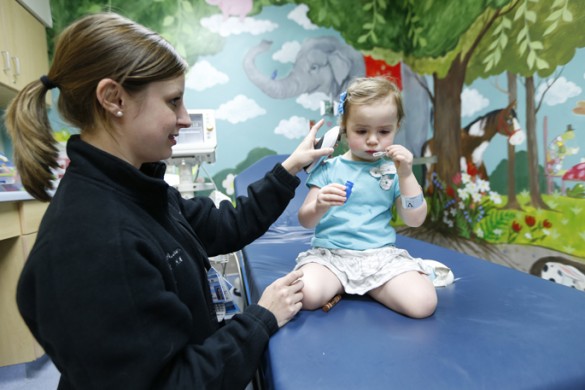
A new protocol put into place more than a year ago at Monroe Carell Jr. Children’s Hospital at Vanderbilt is showing early signs of improving outcomes for patients with traumatic brain injuries.
For the past 16 months, doctors and nurses have been following the new protocol when treating patients with severe brain injuries, with a goal to standardize care for those types of cases at the hospital.
“Everything is aimed at reducing secondary insults after the initial trauma,” said Jay Wellons, M.D., MSPH, professor of Neurological Surgery and Pediatrics, who led the team to create the protocol.
The research team, comprised of members across pediatric subspecialties including intensive care, the trauma service and the emergency department, compared the number of patients who had positive outcomes, such as recovering and going back home, to patients who had negative outcomes, such as entering a rehabilitation center or dying from their injuries.
Under the new standardized protocol, the number of positive patient outcomes rose significantly when compared to the previous five years, said Wellons, the hospital’s chief of Pediatric Neurosurgery.
“We have found that there is now a five-times higher likelihood of the children going home with their family upon discharge,” he said. “It’s validating to us as clinicians and validating to us as researchers.”
In developing the protocol, the team of researchers drew on evidence-based recommendations for handling traumatic brain injuries as well as recent discoveries for which care choices have proven effective.
For doctors and nurses treating patients with severe traumatic brain injury, the new guidelines help provide a clear path for what steps to do and when, said Truc M. Le, M.D., assistant professor of Pediatrics and Neurological Surgery, who helped develop the protocol.
“This is the road map that shows you the easiest way to get to the top of the mountain,” Le said.
More time is needed to determine how the new guidelines will impact patient outcomes in the months and years ahead, but with such positive signs from the first year the team of researchers is optimistic on the long-term benefit of the protocol.
“We hoped that there would be an improvement in outcomes, but we were surprised to see such an improvement so quickly,” said Chevis Shannon, MPH, MBA, Dr.PH., director of the Vanderbilt Pediatric Neurosurgery Clinical Research Initiative, which has been analyzing the impact of the new protocol.
“Now we’ve got to see whether that trend continues,” said Shannon, a research assistant professor of Neurological Surgery. The team also wants to look at how patients fare when integrating back into their families and society, she said.
In the meantime, the researchers hope the initiative to standardize care for a certain population of patients could serve as an example for how doctors and nurses across different departments can use the same approach when treating patients, Wellons said.
“When everyone is on board and following an evidence-based protocol — from the emergency medical personnel at the scene to the nurses and doctors at the bedside — it leads to this type of impact on the children of our community,” Wellons said.















